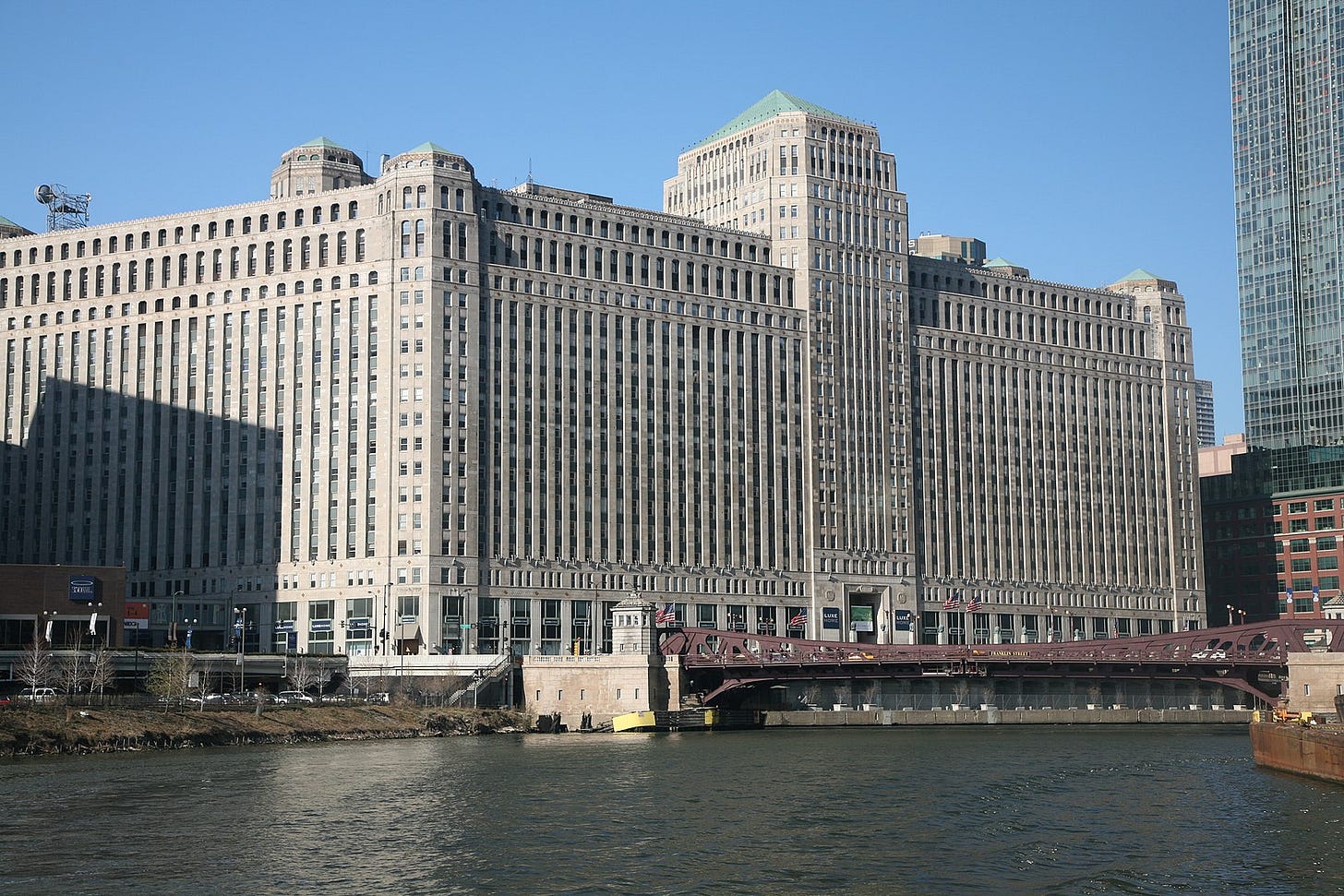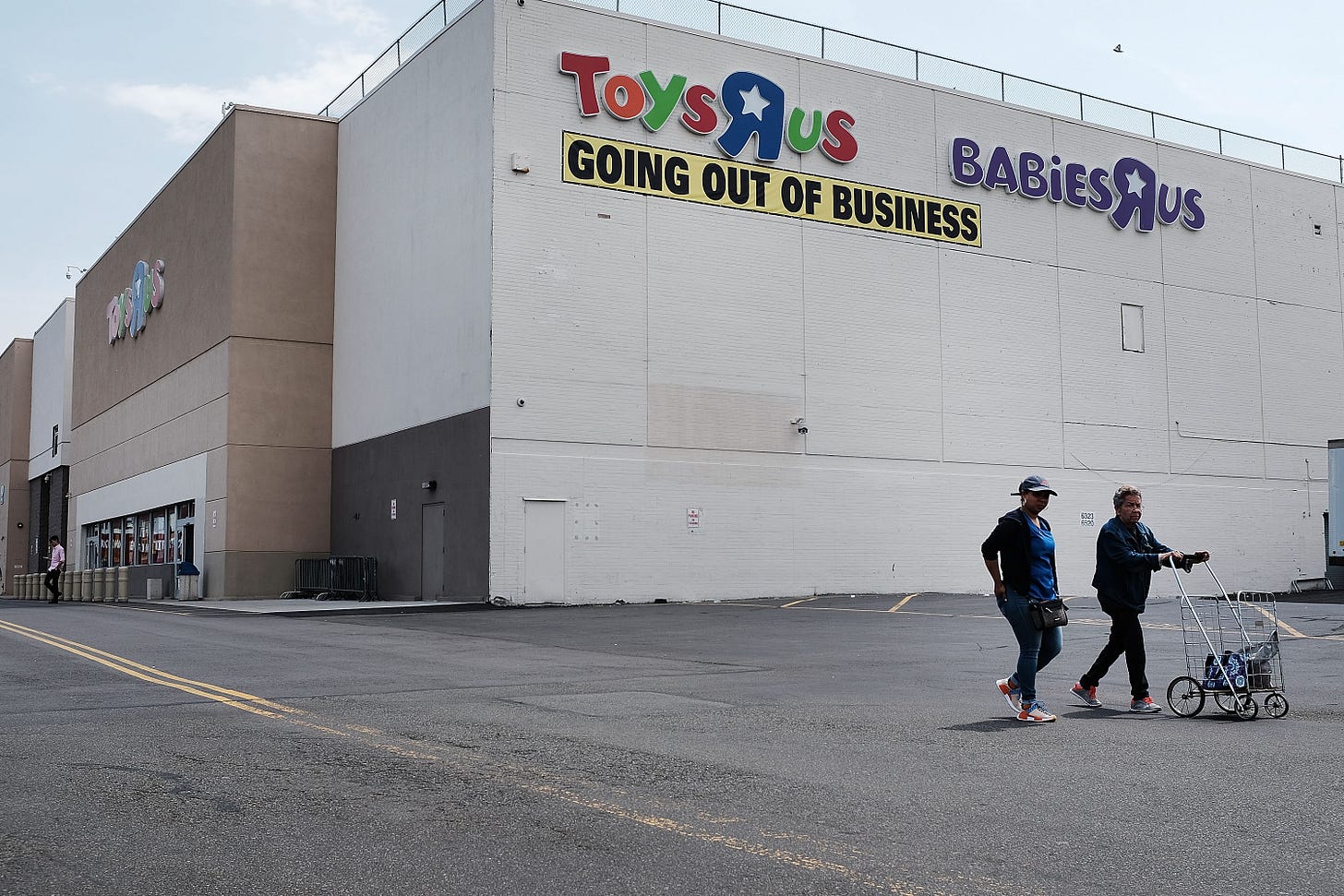The Curious Case of a Toys ‘R’ Us Killer
Vornado’s twisting corporate history tracks long-term trends in retailing and manufacturing.
Several lifetimes ago—March 2018, to be precise—Toys ‘R’ Us began to liquidate its stores after a final bout with bankruptcy. If the company lives on in any way, it is almost certain to be only as a trademark, much as Radio Shack and Montgomery Ward still exist as brand names associated with unrelated e-commerce operations. The actual toy retailer, which began in what’s now a bar in the Adams Morgan neighborhood of Washington, D.C., is as dead as a busted wind-up motor.
The common characterization of the toy giant’s death was that private equity firms killed it, with plentiful reference to the involvement of Bain Capital. This places it in the same shoes as Sears, Payless, and other stodgy retailers whose slow but perhaps manageable declines were accelerated by “vulture capitalists.” Of course, competition from Internet retailers, especially Amazon, was a major factor. There were also some weak attempts to fashion a natalist or anti-feminist argument out of the toy retailer’s demise, to the effect that Toys ‘R’ Us might have survived if people were having more kids.
A more subtle, but very real, element of the Toys ‘R’ Us story involved the real-estate firm Vornado Realty, a third major stakeholder of Toys ‘R’ Us after Bain and a second private equity firm, Kohlberg Kravis Roberts. While some commentary picked up on the obvious connection between a real-estate firm and a large, ailing brick-and-mortar company, much of the press coverage mentioned Vornado only in passing, if at all. Ironically, Vornado didn’t end up faring too well as a Toys ‘R’ Us owner, and the company now focuses almost entirely on high-end commercial real estate in New York City.

Vornado owns the gigantic Merchandise Mart in downtown Chicago. (Photo by Daniel Schwen [CC BY-SA 4.0])Vornado’s website links to a 400-page interactive flipbook of its Manhattan property portfolio, and states that it “owns and operates nearly 20 million square feet of prime office properties.” It also holds select prestigious properties in other cities, such as Chicago’s huge Merchandise Mart, which their website describes as the “largest privately held commercial building in the United States” and “one of the world's leading commercial buildings.” (Vornado’s 2020 revenue came in at $1.5 billion; for comparison, WeWork, with a much larger, global footprint, and which I wrote about here recently, had only $3 billion in revenue.) In 2015, just three years before Toys ‘R’ Us went belly-up, Vornado spun off its Urban Edge Properties division, consisting of suburban strip-retail holdings from its earlier days, concentrated in New Jersey, New York, and Pennsylvania.
So why Toys ‘R’ Us? Forbes contributor Brad Thomas suggests Vornado was simply getting out of its lane in the pre-Recession years, when the three-way Toys ‘R’ Us acquisition took place.
It is worth taking a closer look at Vornado’s corporate history, with all its surprising twists and turns, because of what it can teach us about the broader story of the American economy over the last century.
The company traces its roots back to the early 1930s, to the Wichita, Kansas-based electric fan manufacturer O.A. Sutton Corporation, which released its first “Vornadofan” in 1945. Thus “Vornado” actually began as a product line, not a company name. The Sutton company would find success with fans, air conditioners, and related products, until sales began to flatline in the late 1950s. Following this period of financial trouble, a New Jersey-based regional discount department store chain called Two Guys acquired O.A. Sutton in 1959. Two Guys subsequently renamed its company—though not its stores—Vornado.
A brief background on Two Guys: Peaking at 60 stores, some of which included supermarkets and approached 200,000 square feet (larger than a current-day Walmart supercenter), these stores were in many ways the forerunner of the modern big-box discount department store. Their name also had origins in something a little more colorful. The two founders were dubbed “those two bastards” by a competitor, and so they attempted to name their chain “Two Bastards.” No newspaper would run an ad for that, and so “Two Guys” sufficed. At one time, Two Guys was the fifth-largest discount chain in the nation.
After the acquisition of O.A. Sutton, Two Guys expanded and outsourced the old Sutton manufacturing lines, much of it to Japan, and Vornado became Two Guys’ in-house brand for a new line of discount home appliances, including hair dryers, can openers, and blenders. (Full disclosure: I’m the proud owner of a 1970s Vornado blender made in Japan, and it is fantastic).
This arrangement worked well enough into the 1970s, when the Two Guys stores began to feel pressure from malls and other more “modern” retailers. They also made an unwise acquisition of a West Coast supermarket chain, a failed attempt at expansion reminiscent of many other defunct retailers. Though the stores never actually became unprofitable, they had entered steep decline by the early 1980s; retailing concepts and styles had evolved past the chain, whose stores were becoming shabby and dated.
And so Two Guys—corporate name Vornado—determined that its choice suburban real-estate parcels, owned by the company rather than leased, and growing in value for roughly two decades, were worth more than the revenue from the stores. Vornado shuttered the Two Guys stores and got into the commercial real-estate business, beginning with the former buildings and parcels of its erstwhile stores.
What about the Vornado appliance line, which you may see in stores today? Vornado Realty licensed the name in the late 1980s, and Michael Coup, who secured the trademark, actually hired Sutton’s original Vornadofan designer to design a new fan with classic notes. While the modern-day Vornado appliance company is based in Kansas, as Sutton was, these days it has essentially nothing to do with Sutton, Two Guys, or Vornado Realty.
To sum up, then: A pioneering regional brick-and-mortar retailer acquires an American manufacturer. The manufacturing is subsequently offshored, and eventually the overall company, while still profitable, is sold for parts and morphed into a commercial landlord. The Vornado name lives on as a brand, under license, printed on mostly Chinese-manufactured fans (although they are designed and engineered, and in some cases assembled, in the United States). And then, the real-estate firm plays a part in the death of another struggling retailer in Toys ‘R’ Us—a company much in the same position as its own previous incarnation as Two Guys.
There was, however, one more twist. By the mid-1960s, Two Guys’ original founders had departed, leaving the chain in the hands of a personally less invested management (the ill-advised supermarket merger took place only a couple of years after this shift). Vornado/Two Guys had gone public in 1957, and the stores’ declining fortunes opened it up to acquisition. In 1979, a shopping-center developer called Interstate Properties took control of Vornado, and Steven Roth, one of Interstate’s three founders, became the brains behind Vornado’s shift into commercial real estate. Roth, who turns 80 this year, is today the chairman of Vornado Realty Trust. It all makes Two Guys look even more like Toys ‘R’ Us.
This tortuous story is a very specific but illustrative example of how offshoring and financialization can be in tension with the “real economy.” On the other hand, it reveals that these trends have been in development for decades—that they’re neither recent nor easily or obviously reversible.
Of course, a fan manufacturer and a suburban big-box retailer don’t sound like the kinds of failed enterprises that deserve to be widely mourned. But they’re worth understanding, because despite their pedestrian appearances, they tell a story that began in Kansas in the 1930s, and is still unfolding today.



